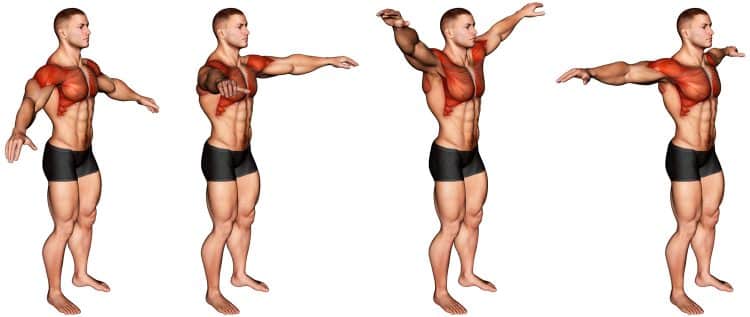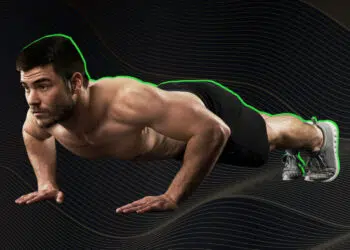Skipping warm-up is a common mistake among beginner and advanced lifters. Warm-up exercises help loosen your muscles and prime your joints, lowering the risk of injury while training.
Arm circles are an incredibly effective dynamic warm-up exercise to be done at the beginning of an upper-body workout. It helps prepare your arms and shoulders for the ensuing mayhem.
The best part about arm circles is that they are an easy-to-perform bodyweight exercise that can be done anywhere. This article elaborates on the advantages, cons, methods, muscles worked, alternatives, and variations of arm circles.
What Muscles Do Arm Circles Work?
Arm circles primarily work the shoulders. They also result in upper arm and upper back stimulation. Keep the reps slow and controlled to make the most of this exercise.

Benefits of Arm Circles
Given below are the benefits of performing arm circles:
Level Up Your Fitness: Join our 💪 strong community in Fitness Volt Newsletter. Get daily inspiration, expert-backed workouts, nutrition tips, the latest in strength sports, and the support you need to reach your goals. Subscribe for free!
1. Improves Mobility
Performing a dynamic stretching exercise like arm circles at the beginning of your workout can improve your mobility, flexibility, and reach, enabling better muscle fiber recruitment.
Arm circles should be a part of your pre-training ritual if you deal with a limited range of motion. Spend anywhere between 5-10 minutes on your warm-up routine.
2. Lowers Risk of Injury
Doing arm circles at the beginning of an intense upper-body training session or strenuous physical activity can lower the risk of injury. Tasks that require explosive strength, like throwing a football can lead to shoulder injury if you’ve not warmed up your shoulders properly.
On the other hand, unknown to most lifters, stiff shoulders are one of the most common reasons behind a biceps tear. Properly warming up your shoulder rotator cuffs can significantly reduce your risk of injury while training.
3. Can Be Done Anywhere
Arm circles are a bodyweight dynamic stretching exercise that can be done anywhere. You could do it before a training session to warm up your upper body or right after you get out of bed to loosen up your stiff muscles.
Plus, arm circles can be done standing, while chilling on your bed or sofa, or in front of your computer. There are no excuses to skip an arm circle session.
4. Perfect for Pre-Training
Arm circles are a form of dynamic stretching that helps get you ready for your training regimen. Many lifters make the mistake of performing static stretches like overhead triceps stretch, biceps stretch, and cobra in their pre-workout routine.
Per The American Council on Exercise (ACE), static stretches should be saved for after your workout, as they signal your muscles to relax rather than activate.
5. Suitable For People of All Experience Levels
Arm circles are a basic exercise that does not require years of training experience and are used by pros and beginners alike to loosen up before a workout.
Depending on your activity level throughout the day, you can add arm circles into your routine to keep your upper body active and mobile.
6. Burn Calories
Besides helping you get ready for your workouts, arm circles can aid in burning calories. Per some estimates, doing five minutes of arm circles, along with other exercises like desk push-ups and arm punches, twice a day, can help burn up to 100 extra calories per week.
You should perform each of the three exercises for a minute and rest for a minute before moving on to the next exercise. In the five-minute routine, you’ll be exercising for three minutes and resting for two.
How To Perform Arm Circles
This is how to perform the arm circles with the correct form:
- Stand upright with a shoulder-wide stance.
- Extend your arms to your sides. They should be parallel to the floor.
- Push your shoulders back and down to get in position.
- Rotate your arms clockwise at your shoulders.
- Arm circles are usually performed until you feel a burn in your shoulders or if you can’t hold your arms parallel to the floor.
- Alternatively, you could perform 10-20 clockwise arm circles and then perform an equal number of anticlockwise reps.
- Target Muscle Group: Shoulders
- Secondary Muscles: Upper arms and upper back
- Type: Dynamic stretching
- Mechanics: Compound
- Equipment: Bodyweight
- Difficulty: Beginner
- Best Rep Range: 10-20 (each side)
Pro Tip: Start performing arm circles with smaller circles and slowly work your way into bigger circles. Keep your core braced to limit spinal movement.
How to make arm circles harder?
With time, arm circles will become a walk in the park for you. You can raise the exercise’s difficulty level by holding onto light dumbbells or wearing wrist weights. It will make the exercise a lot more challenging and demanding.
Common Mistakes While Performing Arm Circles
Here are some of the most common mistakes while performing arm circles:
1. Bending Your Back
Some people bend their backs while performing arm circles. Doing so can take away tension from your delts and put in on your traps and rhomboids.
Furthermore, people with poor posture tend to slouch their shoulders or bend their elbows while performing arm circles. Maintain an upright back and the natural arch in your lower back to get the best bang for your buck while performing this exercise.
2. Using Weights Too Soon
Many excitable lifters jump the gun and add weights to arm circles too soon. It not only hampers the exercise’s effectiveness but puts their joints under unnecessary stress, increasing their chances of injury.
Why are arm circles considered a dangerous stretching exercise?
With all said and done, arm circles might not be for everyone. People dealing with shoulder injuries should consult their physicians before adding this exercise to their training regimen.
Level Up Your Fitness: Join our 💪 strong community in Fitness Volt Newsletter. Get daily inspiration, expert-backed workouts, nutrition tips, the latest in strength sports, and the support you need to reach your goals. Subscribe for free!
Plus, arm circles can cause pain and sometimes shoulder impingement because of the position of the arms. You should stop performing this exercise if you feel shoulder discomfort or pain.
Alternatives For Arm Circles
Add the following arm circle alternatives to your training regimen to improve your shoulder mobility and agility:
1. Downward Dog
The downward dog is a yoga pose that is slowly but surely making its way into the strength training circuits. Performing 10-20 reps of downward dog will get you primed for the most intense workouts.
Steps:
- Get into a tabletop position with your wrists underneath your shoulders and your knees underneath your hips. This will be your starting position.
- Curl your toes under and push back through your hands to lift your hips and straighten your legs.
- Engage your abdominals as you push your body off the mat so only your hands and feet are on the mat.
- Contract your quads to lessen the burden on your arms.
- Keep your tail high and ensure your heels are on the floor at the top.
- Slowly return to the starting position.
- Repeat for recommended reps.
Pro Tip: Although 20-30 reps of this exercise are sufficient to prime you for your workout, you can make this exercise harder by performing it while wearing a weighted vest.
2. Band Pull-Apart
Band pull-apart is a low-impact exercise to warm up your shoulders. Using a resistance band keeps constant tension on your shoulders throughout the exercise.
Steps:
- Stand upright with a shoulder-wide stance.
- Grab an end of a resistance band in each hand using an overhand grip. Position your hands so they are shoulder-width apart at chest level.
- Extend your arms straight in front of you so they are parallel to the floor. Your arms should remain parallel to the floor throughout the exercise.
- Move your hands to your sides until your arms are in line with each other.
- The resistance band should be touching your chest at the top.
- Slowly return to the starting position.
- Repeat for recommended reps.
Pro Tip: Make the exercise harder by holding the resistance band with a narrow grip. Alternatively, you could use a heavy-resistance exercise band.
Check out our complete band pull-apart guide here!
3. Y-Raise
The Y-raise is an incredibly effective exercise to improve your shoulder mobility. It can also be used as a warm-up exercise to prepare your delts for upper body workouts.
Steps:
- Lie prone on the floor. Tuck your chin and pelvis slightly to create a neutral spine. Keep your feet shoulder-width apart.
- Extend your arms overhead and to the sides at 45 degrees to create a Y shape with your upper body.
- For optimal delt recruitment, rotate your hands outward so your thumbs are pointing up and palms facing each other.
- Keeping your head and torso still, squeeze your shoulder blades together so that both arms raise off the floor.
- Pause at the top for optimal muscle fiber recruitment.
- Slowly lower your arms back to the floor.
- Repeat for recommended reps.
Pro Tip: You can try more advanced variations like the cable Y raise as you get better at this exercise.
Check out our complete cable Y raise guide here!
4. Face Pull
Face pulls train your upper posterior chain muscles. They primarily target your rear delts and help build the coveted 3D shoulders.
Steps:
- Set a cable pulley at your face level and connect a rope attachment.
- Stand at an arm and a half distance from the cable pulley with a shoulder-wide stance. Alternatively, you could assume a staggered stance for better balance.
- Push out your chest slightly and maintain the natural curve in your lower back.
- Grab both sides of the handle with an overhand grip.
- The cable should be taut at the starting position.
- Pull the rope toward your face as far as you can and contract your rear deltoids while pulling both sides apart.
- Pause and contract your rear delts at the top.
- Slowly return to the starting position.
- Repeat for the desired number of reps.
Pro Tip: You could fix a resistance band in a door or tie it around an elevated surface if you do not have access to a cable pulley machine.
Check out our complete face pull guide here!
5. Lawn Mower Pull
The lawn mower pull is an underutilized exercise in the strength training circuit. This full-body dynamic stretching exercise deserves a place in your warm-up regimen.
Steps:
- Stand with your feet shoulder-width apart in a staggered stance.
- Place one end of a resistance band under your front foot. Hold the other end with your opposite hand, so the band goes diagonally across your body.
- Keeping your other hand on your hip and without locking your knees, bend slightly at the waist.
- As if starting a lawn mower in slow motion, straighten upright while pulling your elbow across the body to your outside ribs.
- Your elbows should be at shoulder height at the top.
- Slowly return to the starting position.
- Repeat for recommended reps before switching sides.
Pro Tip: Turn to the side of your rear leg as you reach the top of the movement. Pause and contract your abs and shoulders for optimal muscle fiber recruitment.
FAQs
Is it compulsory to warm up your shoulders before an upper body workout?
Deltoids (anterior, side, or posterior) are engaged in almost all upper-body exercises. Hence, it becomes imperative to warm them up before a demanding training session.
Does performing arm circles while seated have the same results as doing them standing?
Yes, doing arm circles while seated is as effective as performing them standing. However, you need to ensure you’re doing them with the perfect form to get the best bang for your buck.
Can I do weighted arm circles?
You can do weighted arm circles if the bodyweight version feels too easy. Nonetheless, ensure you’re not overexerting your shoulder rotator cuffs by going too heavy, as it can lead to shoulder impingement and other injuries.
Wrapping Up
Arm circles are an incredibly effective dynamic bodyweight stretching exercise that can improve mobility and range of motion, lower the risk of injury while training, and help burn calories.
This extensive exercise guide lists everything you should know about arm circles to make the most of them. Plus, we have listed five arm-circle alternatives to spice up your workouts. We hope this article will help improve your shoulder health and boost your functionality. Best of luck!








